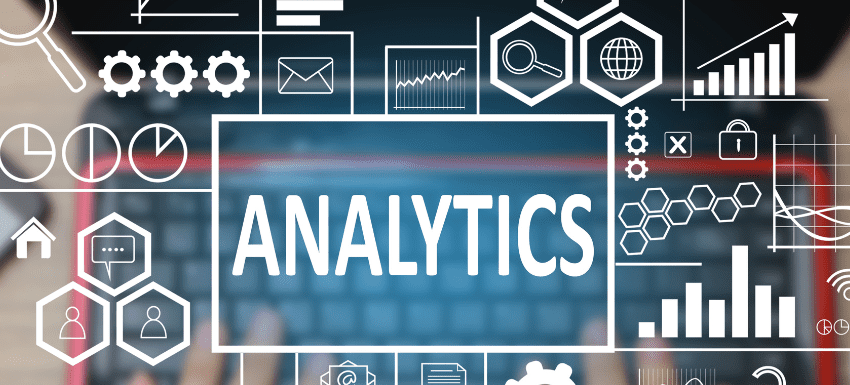Advanced analytics involves complex, modern techniques that organizations use to make better predictions and business decisions.
Traditional data analytics and business intelligence techniques seem to be inefficient for many use cases in this technologically advancing world.
Nowadays, many organizations are moving from traditional methods to modern techniques and are now harnessing the benefits of advanced analytics.
Many techniques used in advanced analytics encompass artificial intelligence (AI), machine learning (ML), and more to help organizations in a variety of ways.
Whether it’s developing marketing campaigns, finding loopholes in new institutional policies, or improving security in banking systems, the usage of advanced analytics is growing.
In this article, I’ll discuss advanced analytics and how it’s important for your business.
Let’s start!
What Is Advanced Analytics?
Advanced analytics is a data analytics methodology leveraging different analytics tools and techniques to forecast events, predict an outcome, make better decisions, and gain valuable insights in order to improve business.
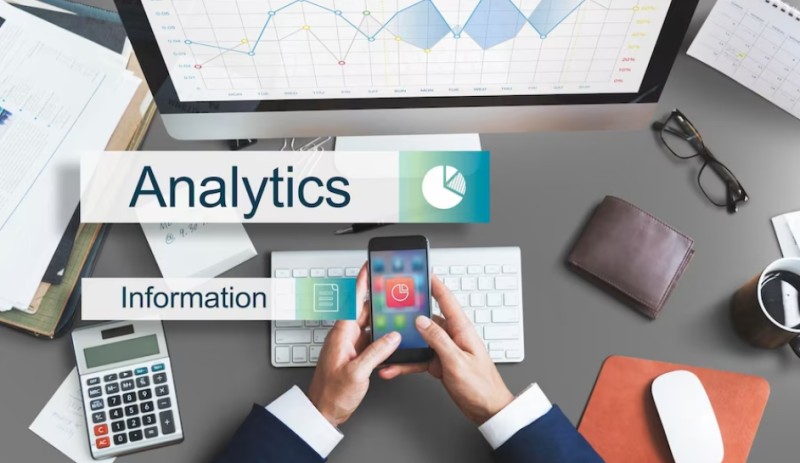
Analytics techniques used here are AI, ML algorithms, predictive modeling, business process automation, deep learning, and more to learn and analyze business data from multiple sources. Advanced analytics solutions and tools extend and combine both prescriptive and predictive analytics to visualize data, find patterns, and improve decision-making.
Advanced analytics finds usage in various industries and businesses, including data mining, marketing, advertisement, and cybersecurity. Many businesses use it to gain insights into their business, find loopholes in policies, anticipate market dynamics, find new market trends, and utilize it for many other purposes.
Many complex methodologies, like digital culture, cluster analysis, complex event processing, multivariate statistics, decision intelligence, etc., are also expected to be included in advanced analytics.
The list of methodologies under the umbrella of advanced analytics is constantly growing, and with time, new techniques are being adopted. However, the basic tasks that this analytics method helps accomplish are segmentation, classification, correlation, forecasting, and association.
- Segmentation helps in combining different similar data
- Classification assists in classifying unclassified items
- Correlation is one task that identifies the connection between the properties of items
- Forecasting task gives the business a predictable future outcome
- The association helps the business assess the number of times a joint occurrence of two data might occur in a raw data set. It also helps in identifying the derivation of rules
Advanced Analytics: Benefits

Advanced analytics is a powerful method used by many businesses across the globe. It gives businesses access to numerous data analytics techniques that help them to avert business challenges and grow the organization.
The benefits of advanced analytics are:
- Accurate forecasting: The primary benefit of advanced analytics that has attracted most businesses toward it is the high level of accuracy in forecasting.Unlike old BI tools that still make use of elements of uncertainty, advanced analytics can predict the outcomes more effectively and help you decide whether you should make your business decisions in that direction.
- Better risk management: Risk is part and parcel of any business, and advanced analytics serves as the best solution for minimizing it. The high prediction accuracy helps the organization in better risk management and curbs the chance of costly mistakes. Whether you are starting a new venture or launching a product, advanced analytics can help you prevent potential loss.
- Getting deep into details: With advanced analytics tools, you can have deeper actionable insight into market data. By analyzing market dynamics and utilizing predictive modeling, you can identify the potential of your next business step in the market.
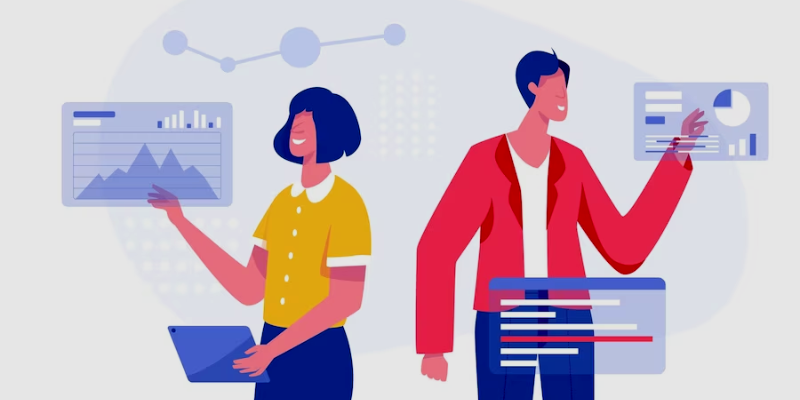
- Quicker decisions: With highly accurate future predictions, you can make quicker decisions on any business strategy. It helps you to back any decision where you have predicted any favorable outcome.
- Curbs down biases: Another major benefit of implementing advanced analytics is its ability to curb cognitive biases that can negatively impact any business decision. Advanced analytics uses machine learning and AI that gives you a more data-driven outcome and logical solution to a decision.
- Anticipating opportunities and problems: By using reliable advanced analytics tools, businesses can identify new opportunities in the market and act as per demand. Moreover, it can also help you spot potential problems in your business approach and make changes accordingly.
Techniques of Advanced Analytics
Advanced analytics involves a variety of techniques that work together to help organizations make predictions and business decisions. Here are some popular techniques:
- Data Mining: Data mining is one of the most used techniques that is utilized for identifying patterns, loopholes, and trends with a given data set. It also helps in establishing a relationship between variables in a data set to solve potential issues. Data mining combines AI, statistics, and machine learning to perform tasks effectively.
- Sentiment Analysis: Sentiment analysis is a modern technique that utilizes natural language processing (NLP), biometrics, and text analysis to check whether the text is negative, neutral, or positive. It helps businesses in analyzing the emotion of their potential customers and how they perceive a brand or a new product.
- Big Data analytics: It is another well-known technique that is implemented in advanced analytics to assess a vast amount of unstructured, semi-structured, and structured data. This technique is highly useful for finding out market trends, the correlation between entities, hidden patterns, customer liking, and other hidden information from a large set of data.
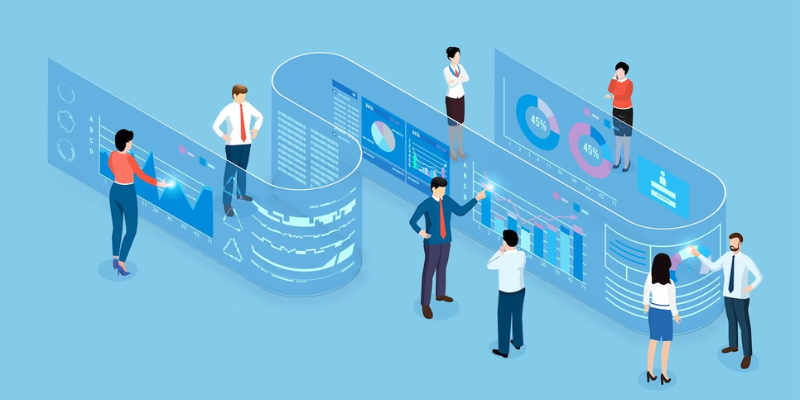
- Data Visualization: Data visualization presents data in a graphical format. It is a standard analysis practice by business entities to showcase analysis and other information through a graphical representation. Data visualization is more than just graphs and flowcharts; it shows a lot more information, like how your business is doing and where it’s headed to.
- Cluster analysis: Advanced analytics utilizes cluster analysis to analyze unstructured data sets and identify clusters of similar data points. It is a common analysis method that helps businesses classify unstructured data and utilize them for finding related information. Not only similarities, this technique also helps in finding differences in those data points and showcasing them visually.
- Machine Learning: Without a doubt, machine learning is a highly used advanced analytics technique where it learns vital information from collected data sources and produces a detailed model. This helps in identifying complex patterns and creating accurate predictions that will help decide the roadmap of the organization.
- Complex event processing: Complex event processing is a useful method that helps track and analyze streams of structured data in real time and predict highly-accurate actionable conclusions. It utilizes a specialized technique of pattern matching to recognize any event or action and provide all the vital information on how to respond to that event.
- Cohort analysis: This technique helps in breaking huge sets of data into related sets and using the insights to make your next move on the target market.
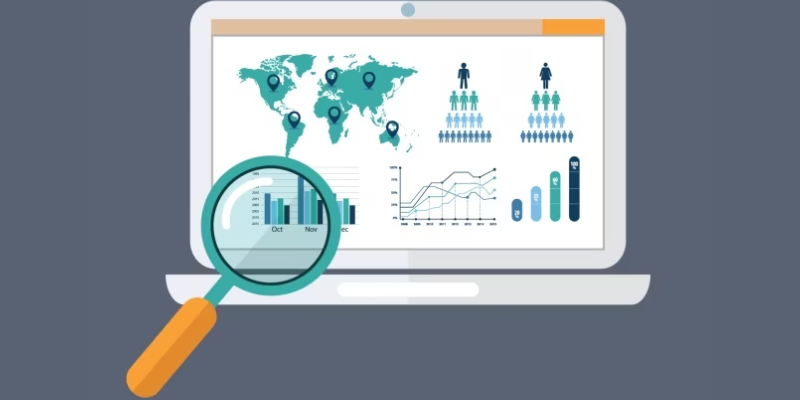
Businesses use this technique to declutter large amounts of customer information based on different analyses and then segregate them into relatable groups. It is often used for testing the accuracy of hypotheses of different assumptions based on sample data.
- Predictive modeling: Predictive modeling is widely used by businesses because it helps them in making predictions about future outcomes of a business strategy. The prediction is based on historical data, and this technique uses machine learning and statistical modeling to forecast the outcome. And using predictions, businesses can decide their next moves accordingly while minimizing risks.
- Simulation analytics: Simulation analytics is beneficial for businesses as this technique helps you predict alternative outcomes that can happen during, before, or after a decision has been implemented.
- Multivariate statistics: It is a highly advanced technique that involves different methods to examine the connection between different variables within a data set. It identifies the connection at the same time to provide an accurate result.
- Streaming analytics: Streaming analytics is a modern advanced technique that assesses high-bandwidth streaming data continuously, and that too in real-time. Many businesses running online stores often utilize this technique to understand different information related to sales and customer behavior.
- Prescriptive analytics: Prescriptive analytics is often used by organizations as it combines the attributes of predictive analytics and business intelligence. This technique helps organizations decide the next move and pave the pathway based on past records.
Business Intelligence vs. Advanced Analytics
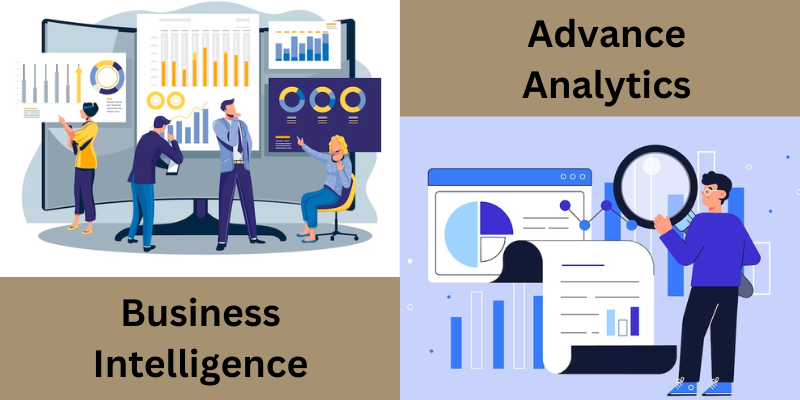
Business intelligence (BI) and advanced analytics are the two most popular choices for business organizations to help them make highly accurate data-driven decisions. Even though they aim for similar tasks, there are many differences between them.
| Advanced Analytics | Business Intelligence | |
| Definition | Advanced analytics uses various modern techniques and modeling strategies to predict the future and make decisions accordingly. It’s mainly oriented toward future events. |
BI uses previous performances and historical data to help an organization improve its business. It’s mainly oriented toward past and present events. |
| Primary Purpose | Its primary purpose is to find out complex issues in a business and decide the course of action accordingly. | It helps in getting insights into historical data and addressing minor issues. |
| Main Techniques Involved | Techniques involve data mining, machine learning, semantic analysis, cohort analysis, pattern matching, and many more. | Techniques involve data mining, reporting, and querying. |
| Big Data Usage | It frequently utilizes Big Data. | It almost regularly uses Big Data. |
| Analysis Type | It makes a highly accurate predictive analysis. | It finds out the root cause of the data pattern. |
| Data Type Usage | Advanced analytics uses both unstructured and structured data types. | Business intelligence involves majorly structured data types. |
| Approach | It takes a proactive management approach. | It makes a reactive business approach for processing information. |
| Knowledge Generation | Knowledge is automatically generated in this method. | Knowledge is generated manually. |
| Users | Business analysts and data scientists are the main users of advanced analytics. | It is mainly used by business analysts and users. |
Use Cases of Advanced Analytics
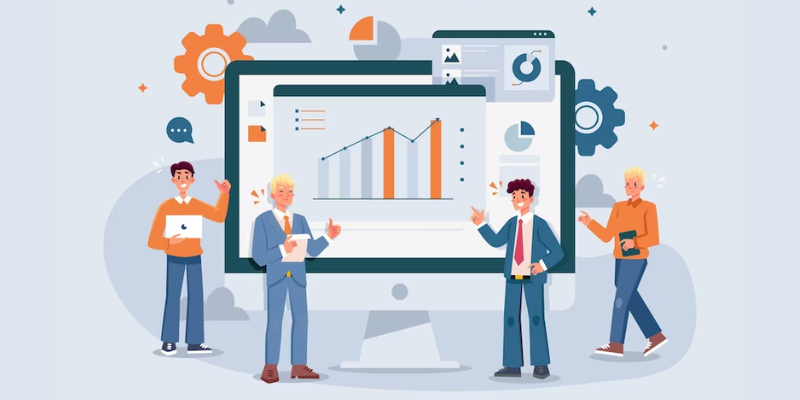
Advanced analytics can be used in many ways in your current business ecosystem, such as:
- Supply chain optimization: Advanced analytics can help your organization evaluate demand, changing customer preferences, adjust to cost fluctuations, and create a dynamic supply chain. It makes the supply chain adaptable to quick market changes and helps in reducing delays, curbing distribution costs, and streamlining processes.
- Performing marketing analysis: It helps businesses make customized and targeted marketing campaigns and sell products. This way, you can avoid ineffective strategies and reduce money wastage. By analyzing future outcomes, you can identify the chances of up-sell and cross-sell and also enhance customer experience.
- Streamlining business operations: With advanced analytics, you can streamline your operation and make them adapt to changing market trends. Unlike BI tools that might not appropriately adapt to changing market conditions, advanced analytics can help improve the performance, revenue, and productivity of your organization.
- Analyzing risk vectors: By implementing advanced analytics, businesses can analyze huge data sets and data streams in real-time. This allows you to detect patterns in data that can pose greater risks to the organization. From payment fraud and policy loopholes to insurance liabilities and monitoring customer reputation, advanced analytics can help mitigate risks and save money.
Some Advanced Analytics Tools
#1. Countly
Countly is an efficient advanced analytics tool that can help you gain deeper insights about your business from your applications. It’s available on a private cloud or can be self-hosted. It lets you track your product’s performance and customer’s behavior and journey on desktop, web, and mobile applications.
Features and benefits:
- Complete data ownership and control
- It’s extensible with the help of plugins
- Easier data access with customizable dashboards
- Product analytics
- Support for tracking strategy
- Interactive push notifications
- Email and crash reporting
- Greater security with user permissions
- Improved data privacy with adherence to compliance regulations like HIPAA, GDPR, and COPPA
On GitHub, it has garnered 5.1k+ stars and 949 forks in total.
#2. Apache Superset
Superset is a data exploration and visualization platform by Apache. This enterprise-ready, modern business intelligence application can augment or replace proprietary BI tools for many businesses.

Features and benefits:
- You can build charts quickly using Superset’s no-code interface
- Perform advanced querying with the powerful web-based SQL editor
- Define custom metrics and dimensions quickly with a light-in-weight semantic layer
- Supports almost all SQL databases out of the box
- Data visualization with many beautiful visualizations like bar charts, geospatial visualizations, etc.
- Extensible options for security authentication and roles
- Configurable and lightweight caching layer to simplify database load
- Customization with an API
It also integrates quite well with multiple data sources and has a cloud-native architecture that’s crafted from scratch for easy scaling.
#3. Great Expectations
Great Expectations (GX) allows data teams to build a common understanding of collected data through better profiling, documentation, and quality testing. It helps you manage your data pipelines effectively and quickly deploy flexible and extensible quality testing.
Features and benefits:
- Seamlessly fits into the current tech stack and integrates with CI/CD pipelines
- Accelerated data discovery, even for larger data volumes
- Auto-generated data documentation
- Better data control and maintenance with governance and security procedures
- Alerts and notifications
- Integrates well with many systems and tools like AWS S3, GCP, etc.
Its documentation is easy to understand for both non-technical and technical users.
Resources to Learn Advanced Analytics
#1. Advanced Data Analytics using Python

This course will help you master advanced analytics by using Python and solving real-time problems.
#2. Advance Analytics with Excel – data analysis toolpak/Solver

This course teaches advanced data analysis in excel using data analysis tools, such as toolpak for statistics and Solver for linear optimization.
#3. Advanced Analytics with Spark- Patterns for Learning
This practical book by four Cloudera data scientists enables you to perform large-scale data analysis using Spark. Here, you will find examples of how to approach and solve different analytics problems.
#4. Advanced Analytics in Power BI with R and Python
The author Ryan Wade has given Python and R recipes to help you apply different languages in the data analytics field to your work in MS Power BI.
#5. Advanced Analytics with Excel 2019
The author Manisha Nigam lets you explore various methods and ways for complex analysis, consolidating data, and forecast based on recent trends.
Conclusion
Advanced analytics can prove to be a highly effective and efficient business strategy to help you grow and shape your goals while mitigating risks. It’s constantly evolving with the advancement of technologies, adding more spectrums and becoming more useful. Big brands are already using advanced analytics, and soon it will spread among others.
You may also explore Augmented Analytics.
Si quiere puede hacernos una donación por el trabajo que hacemos, lo apreciaremos mucho.
Direcciones de Billetera:
- BTC: 14xsuQRtT3Abek4zgDWZxJXs9VRdwxyPUS
- USDT: TQmV9FyrcpeaZMro3M1yeEHnNjv7xKZDNe
- BNB: 0x2fdb9034507b6d505d351a6f59d877040d0edb0f
- DOGE: D5SZesmFQGYVkE5trYYLF8hNPBgXgYcmrx
También puede seguirnos en nuestras Redes sociales para mantenerse al tanto de los últimos post de la web:
- Telegram
Disclaimer: En Cryptoshitcompra.com no nos hacemos responsables de ninguna inversión de ningún visitante, nosotros simplemente damos información sobre Tokens, juegos NFT y criptomonedas, no recomendamos inversiones

